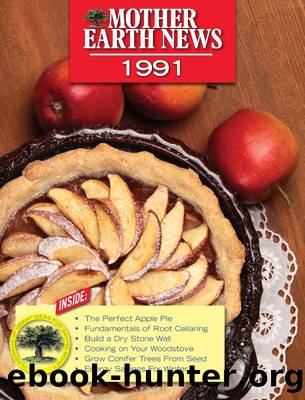Mother Earth News 1991 by Unknown

Author:Unknown
Language: eng
Format: mobi, epub
Ends and Corners
Save the best rocks, those most nearly rectangular and of even thickness, for ends and comers. A wall end must stand on its own, and for appearance’s sake the end stones should have at least one good square corner - or those at the outside edges should. The top stones should be the biggest you can handle. I like to keep the longest rocks for ends, so they can extend as far back into the wall as possible. It is also a good idea to have ends particularly well-tied crosswise.
Corners are more complicated still. First, you want to tie your comer into both lengths of wall - which is to say that in each course it is well to have an extra-long rock extending from the comer into both the north/south and the east/west length of wall. If you lack enough long stones to tie into both walls during each course, alternate them - tying first into one, then the other.
From the footing course up, you must take another precaution. Remember that the comer must withstand the expansion and contraction coming from both lengths of wall. A bias toward the lay-up pattern of one length over the other would cause the corner to work loose in time.
So try not to let any edge of any rock line up with any joint in the course below. Or, don’t let the edge of any rock line up with the edge of a rock below - except, of course, on the outer and inner faces.
In still other terms (this being a bit complicated to explain), put each stone so as to cover as many joints as possible, being sure each covers some north/south joints and some east/west joints.
So now we have a 2-by-3-foot wall with ends and a comer. How about a larger wall? It is more of the same with a few exceptions. First, going much over 3 feet in height, you should increase the base or overall width by some 8 inches for each added foot of height. For example, a 7-foot-high wall needs a 4-feet-8-inch-wide base. For a 10-foot height, the base should be 7 feet wide. Width can remain at the base dimension right to the top or can taper (to a point, if you like).
The higher the wall, the deeper should be your footings. For any wall much over waist high (a major undertaking that presupposes an ample supply of stones), you should go down to below frost level or a depth of 2 feet, whichever is deeper. This is a lot of work lost to the eye forever, but it guarantees a good wall.
Editor’s note: John Vivian’s book Building Stone Walls expands on this subject and discusses how to quarry rock and build stairs, stiles, gates, and retaining walls.
Download
This site does not store any files on its server. We only index and link to content provided by other sites. Please contact the content providers to delete copyright contents if any and email us, we'll remove relevant links or contents immediately.
Cecilia; Or, Memoirs of an Heiress — Volume 3 by Fanny Burney(30938)
Cecilia; Or, Memoirs of an Heiress — Volume 2 by Fanny Burney(30894)
Fanny Burney by Claire Harman(25789)
We're Going to Need More Wine by Gabrielle Union(18080)
Plagued by Fire by Paul Hendrickson(16641)
Cat's cradle by Kurt Vonnegut(13878)
Bombshells: Glamour Girls of a Lifetime by Sullivan Steve(13116)
All the Missing Girls by Megan Miranda(12760)
Leonardo da Vinci by Walter Isaacson(11912)
4 3 2 1: A Novel by Paul Auster(11063)
Adultolescence by Gabbie Hanna(8151)
The remains of the day by Kazuo Ishiguro(7564)
Note to Self by Connor Franta(7029)
Diary of a Player by Brad Paisley(6869)
Giovanni's Room by James Baldwin(5888)
What Does This Button Do? by Bruce Dickinson(5532)
Recovery by Russell Brand(4570)
Born a Crime by Trevor Noah(4517)
The Kite Runner by Khaled Hosseini(4461)
